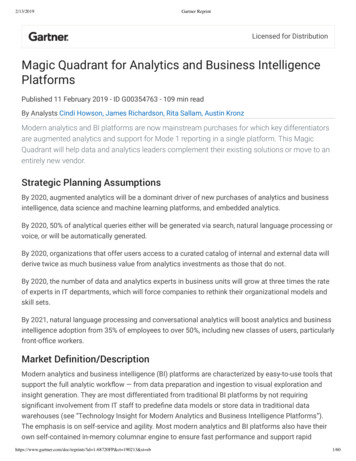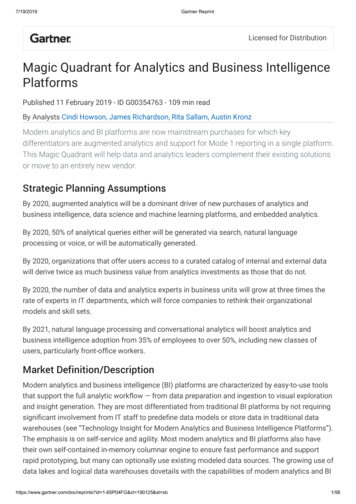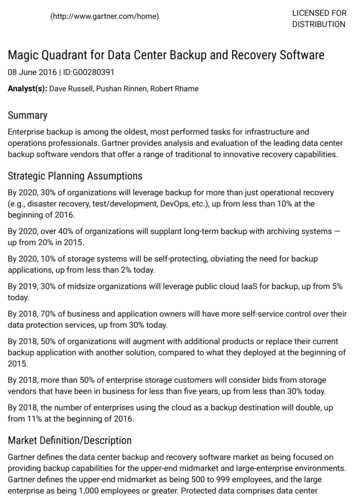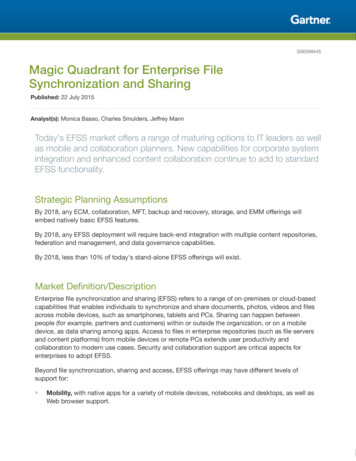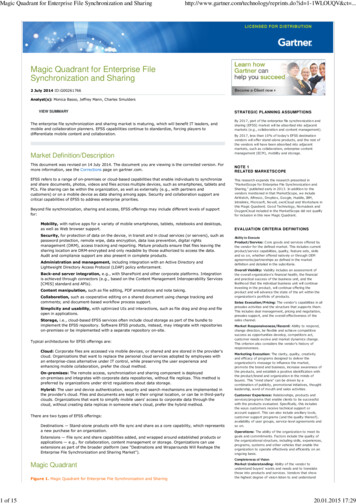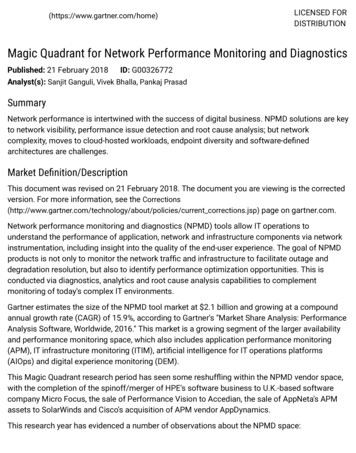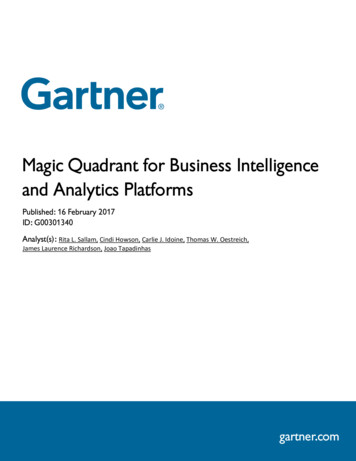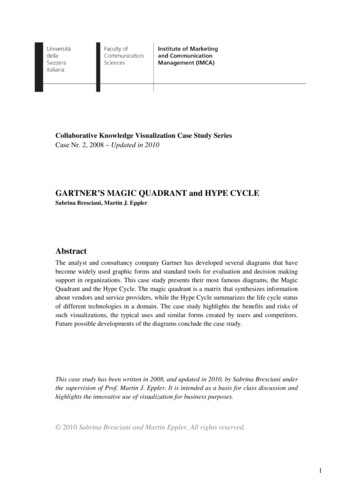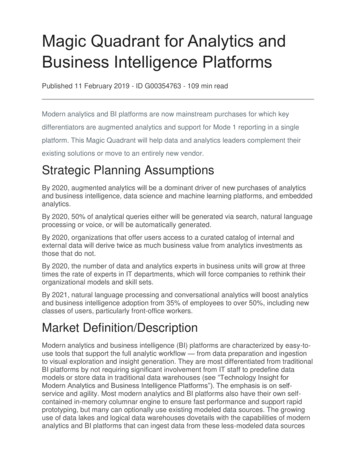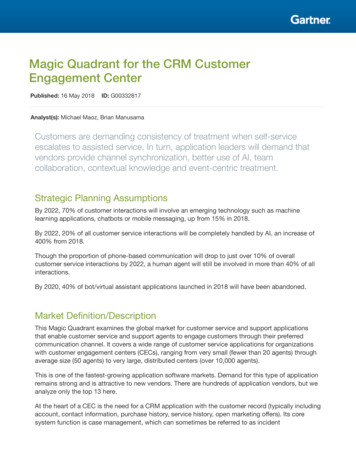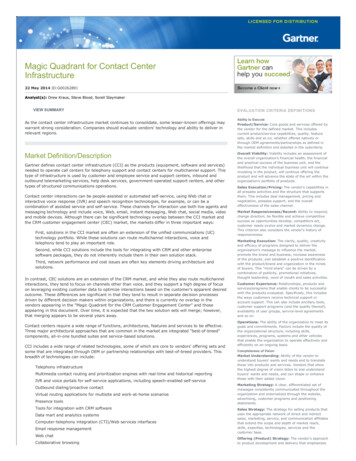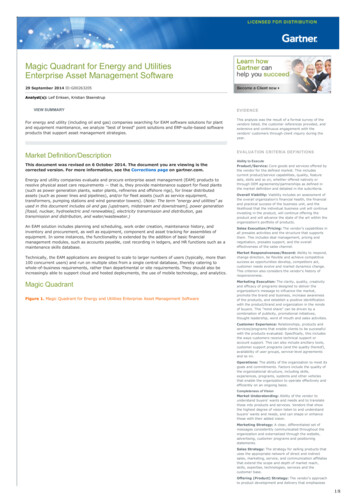
Transcription
Magic Quadrant for Energy and UtilitiesEnterprise Asset Management Software29 September 2014 ID:G00263205Analyst(s): Leif Eriksen, Kristian SteenstrupVIEW SUMMARYFor energy and utility (including oil and gas) companies searching for EAM software solutions for plantand equipment maintenance, we analyze "best of breed" point solutions and ERP suite based softwareproducts that support asset management strategies.Market Definition/DescriptionThis document was revised on 6 October 2014. The document you are viewing is thecorrected version. For more information, see the Corrections page on gartner.com.Energy and utility companies evaluate and procure enterprise asset management (EAM) products toresolve physical asset care requirements — that is, they provide maintenance support for fixed plants(such as power generation plants, water plants, refineries and offshore rigs), for linear distributedassets (such as power lines and pipelines), and/or for fleet assets (such as service equipment,transformers, pumping stations and wind generator towers). (Note: The term "energy and utilities" asused in this document includes oil and gas [upstream, midstream and downstream], power generation[fossil, nuclear, hydroelectric and renewables], electricity transmission and distribution, gastransmission and distribution, and water/wastewater.)An EAM solution includes planning and scheduling, work order creation, maintenance history, andinventory and procurement, as well as equipment, component and asset tracking for assemblies ofequipment. In some instances, the functionality is extended by the addition of basic financialmanagement modules, such as accounts payable, cost recording in ledgers, and HR functions such as amaintenance skills database.Technically, the EAM applications are designed to scale to larger numbers of users (typically, more than100 concurrent users) and run on multiple sites from a single central database, thereby catering towhole of business requirements, rather than departmental or site requirements. They should also beincreasingly able to support cloud and hosted deployments, the use of mobile technology, and analytics.Magic QuadrantFigure 1. Magic Quadrant for Energy and Utilities Enterprise Asset Management SoftwareEVIDENCEThis analysis was the result of a formal survey of thevendors listed, the customer references provided, andextensive and continuous engagement with thevendors' customers through client inquiry during theyear.EVALUATION CRITERIA DEFINITIONSAbility to ExecuteProduct/Service: Core goods and services offered bythe vendor for the defined market. This includescurrent product/service capabilities, quality, featuresets, skills and so on, whether offered natively orthrough OEM agreements/partnerships as defined inthe market definition and detailed in the subcriteria.Overall Viability: Viability includes an assessment ofthe overall organization's financial health, the financialand practical success of the business unit, and thelikelihood that the individual business unit will continueinvesting in the product, will continue offering theproduct and will advance the state of the art within theorganization's portfolio of products.Sales Execution/Pricing: The vendor's capabilities inall presales activities and the structure that supportsthem. This includes deal management, pricing andnegotiation, presales support, and the overalleffectiveness of the sales channel.Market Responsiveness/Record: Ability to respond,change direction, be flexible and achieve competitivesuccess as opportunities develop, competitors act,customer needs evolve and market dynamics change.This criterion also considers the vendor's history ofresponsiveness.Marketing Execution: The clarity, quality, creativityand efficacy of programs designed to deliver theorganization's message to influence the market,promote the brand and business, increase awarenessof the products, and establish a positive identificationwith the product/brand and organization in the mindsof buyers. This "mind share" can be driven by acombination of publicity, promotional initiatives,thought leadership, word of mouth and sales activities.Customer Experience: Relationships, products andservices/programs that enable clients to be successfulwith the products evaluated. Specifically, this includesthe ways customers receive technical support oraccount support. This can also include ancillary tools,customer support programs (and the quality thereof),availability of user groups, service level agreementsand so on.Operations: The ability of the organization to meet itsgoals and commitments. Factors include the quality ofthe organizational structure, including skills,experiences, programs, systems and other vehiclesthat enable the organization to operate effectively andefficiently on an ongoing basis.Completeness of VisionMarket Understanding: Ability of the vendor tounderstand buyers' wants and needs and to translatethose into products and services. Vendors that showthe highest degree of vision listen to and understandbuyers' wants and needs, and can shape or enhancethose with their added vision.Marketing Strategy: A clear, differentiated set ofmessages consistently communicated throughout theorganization and externalized through the website,advertising, customer programs and positioningstatements.Sales Strategy: The strategy for selling products thatuses the appropriate network of direct and indirectsales, marketing, service, and communication affiliatesthat extend the scope and depth of market reach,skills, expertise, technologies, services and thecustomer base.Offering (Product) Strategy: The vendor's approachto product development and delivery that emphasizes1/8
differentiation, functionality, methodology and featuresets as they map to current and future requirements.Business Model: The soundness and logic of thevendor's underlying business proposition.Vertical/Industry Strategy: The vendor's strategyto direct resources, skills and offerings to meet thespecific needs of individual market segments, includingvertical markets.Innovation: Direct, related, complementary andsynergistic layouts of resources, expertise or capital forinvestment, consolidation, defensive or pre emptivepurposes.Geographic Strategy: The vendor's strategy to directresources, skills and offerings to meet the specificneeds of geographies outside the "home" or nativegeography, either directly or through partners,channels and subsidiaries as appropriate for thatgeography and market.Source: Gartner (September 2014)Vendor Strengths and CautionsCGICGI is an approximately 10 billion global business process services and system integration firm withheadquarters in Montreal, Quebec, Canada. CGI entered the EAM market through the acquisition ofLogica in 2013. Logica's EAM product, the Asset & Resource Management (ARM) Suite, is the result ofcombining functionality from prior products, the Work Management Information System (WMIS) andSTORMS (Severn Trent Operational Resource Management System). ARM is more oriented toward workmanagement than asset management.StrengthsARM is particularly well suited for work management centric requirements typically found intransmission and distribution environments.The product is scalable and suitable for large transmission and distribution utilities.It has a strong presence in natural gas distribution environments, in addition to its core electricaltransmission and distribution business.It offers integrated asset investment planning (AIP) through its partnership with Seams.CautionsCGI has no deployments in power generation or in oil and gas.ARM has not been adapted for global delivery, and installation resources are not available.There are limited service provider options (mainly CGI).The product doesn't have integrated inventory/materials management functionality.References report lengthy and costly upgrades, although in some cases this reflects a client'spreference to skip upgrades.IBMIBM is an approximately 100 billion global technology and consulting corporation with headquarters inArmonk, New York. Its Maximo Asset Management product is positioned in the Cloud & SmarterInfrastructure group (formerly Tivoli) within IBM. It is also working with other IBM divisions such as theCloud Services division (for its Maximo SaaS offering) and its Business Analytics division's SPSS (forpredictive maintenance). Maximo is deployed in a broad cross section of energy and utility subsectorsaround the globe.StrengthsMaximo is a highly scalable product that is suitable for very large enterprises.IBM has a mature and extensive global community of EAM support resources and partners,minimizing implementation risks and support shortfalls.The product provides a broad range of functionality to support all energy and utilities subsectors.References rate the product and the value received highly.Maximo offers several industry solutions with enhanced functionality (such as environmental,health and safety [EH&S] in its Maximo for Oil and Gas solution), as well as extensive productpartnerships.2/8
CautionsReferences, customers and prospects report that costs to deploy and maintain are at the high endof the EAM market.Industry solutions are extra cost add ons.Customers report significant hardware requirements to run applications.Mobile strategy has been evolving over the past several years, with the current offering largelyunproven in production.IFSIFS is an approximately 400 million global enterprise application software vendor based in Linkoping,Sweden. It sells ERP, enterprise service management (ESM) and EAM systems, including delivering theEAM module as a point solution. IFS sells its products to a wide range of industries but focuses onasset intensive businesses with significant maintenance and construction requirements. It hasexpanded sales in new geographies; however, its utility industry presence in North America is still verylimited.StrengthsThe IFS Applications product can be deployed in most energy and utilities subsectors.IFS's references report above average satisfaction with both the product and service levels.IFS Applications can be — and is often — deployed as a complete ERP solution, includingfinancials.IFS has a mature mobile strategy, and the product has construction functionality.IFS is able to offer an in house reliability centered maintenance (RCM) module to extendfunctionality.CautionsIFS still has few energy and utilities customers in North America.Its European customer base is heavily weighted toward the Nordic countries and Poland.It has a limited presence in oil and gas (predominantly service companies).There are limited service provider options, though this is improving over time.Infor (EAM)Infor is an approximately 3 billion global enterprise application software vendor based in New York.Infor's EAM product (formerly known as Datastream 7i) had been focused mainly on manufacturing.Infor has increased its EAM product focus and closed new business with utility companies, mainlymunicipal utilities.StrengthsThe product has a strong presence in the water and wastewater subsector.It has one of the highest user satisfaction ratings among its peers.Infor EAM is relatively easy and cost effective to upgrade and maintain.The product is highly configurable.CautionsIts energy and utilities deployments are concentrated among smaller, municipal customers (notunlike Infor's separate Public Sector product described below).It has a limited presence in oil and gas.References report limited or no adoption of Infor mobile solutions.Infor development efforts are diluted by having two products that target the samewater/wastewater market.Infor (Public Sector)Infor is an approximately 3 billion global enterprise applications software vendor based in New York.Infor Public Sector (originally acquired from Hansen) is focused on client type (the public sector,particularly water authorities) rather than functional process. This means it can deliver a broadergovernment business solution, but overlaps in some EAM functionality with its sibling product, InforEAM.StrengthsPublic Sector is part of the broader Infor suite of public sector functionality, including customerservice and HR applications.It has a significant presence in the water and wastewater industries in North America, Australiaand New Zealand.It has above average customer ratings for service and value received.CautionsIt is not suitable for EAM deployments other than public sector utilities.It does not have a significant presence outside of North America, Australia and New Zealand.Infor development efforts are diluted by having two products that target the samewater/wastewater market.MainsaverMainsaver is relatively small, independent, stand alone EAM software vendor based in San Diego. It isprivately held by investors who purchased the Mainsaver product from Titan in 2002. Mainsaver isdesigned specifically for fixed plant environments such as power generation. It is primarily focused onNorth American power markets, but has a growing partnership network outside the continent.3/8
StrengthsMainsaver's references rate its service levels highly.The product is inexpensive, easy and quick to deploy and upgrade.It has been widely deployed by independent power producers, including both conventional andrenewables.CautionsThe product is primarily installed at small stand alone power generation facilities, not enterprisedeployments.Mainsaver has limited presence outside of North America.The product has limited presence in oil and gas, transmission and distribution.Mainsaver's references rate its technology and product below its peers.Oracle (E Business Suite)Oracle is an approximately 38.3 billion global technology company with headquarters in RedwoodShores, California. Oracle's E Business Suite (EBS) is a complete ERP suite solution designed for abroad cross section of industries. The first version of the EBS Enterprise Asset Management (eAM)module was dev
Magic Quadrant for Energy and Utilities Enterprise Asset Management Software 29 September 2014 ID:G00263205 Analyst(s): Leif Eriksen, Kristian Steenstrup VIEW SUMMARY For energy and utility (including oil and gas) companies searching for EAM software solutions for plant and equipment maintenance, we analyze "best of breed" point solutions and ERP suite based software products that
